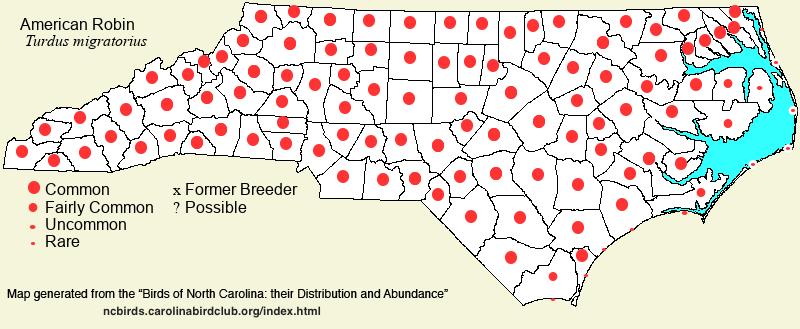 |  |
|
American Robin - Turdus migratorius TURDIDAE Members: | Search Common: Search Scientific: |
|
|
|||||||
| General Comments | The American Robin has been a true success story over the past 50 years. Historically, it was apparently associated with northern coniferous forests, but it has adapted to man's presence about as well as any native bird. Hardly any yard with a sizable lawn seems to lack a pair of them nesting nowadays, especially in the Piedmont and mountains. And, they have greatly spread eastward, to the coast, as breeders in the past two decades. They still occur in the spruce-fir zone in the state, but that is a secondary habitat now. As common as the species is in summer, its numbers are augmented greatly in winter, though robins gather into large flocks at that season, and thus can be locally scarce. Breeding habitats are mainly (now) around lawns, such as in yards or around farmyards; it does not nest in most forested areas, though they can be seen foraging there at times, especially after the young are raised. In migration, robins are often abundant across the state; in winter, robins are quite abundant near the coast, and less so farther inland. In late fall and in winter, robins occur wherever there is an abundance of berries, especially in pocosins, moist forests, and in swamps; thousands can be seen in a few hours. | ||||||
| Breeding Status | Breeder | ||||||
| NC BRC List | Definitive | ||||||
| State Status | |||||||
| U.S. Status | |||||||
| State Rank | S5B,S5N | ||||||
| Global Rank | G5 | ||||||
| Coastal Plain | Permanent resident, with migratory movements. In summer, common to very common in the western third of the province, common in the central portions, and fairly common (and increasing) in the eastern portions. Very rare as a breeder on Hatteras and Ocracoke islands. In migration and winter, abundant (though in flocks) in the coastal and Tidewater areas; common to locally abundant elsewhere, though not abundant in the Sandhills. Peak counts: | ||||||
| Piedmont | Permanent resident, with migratory movements. In summer, very common across the region. Very common to abundant in migration. In winter, common to locally very common in the eastern and southern portions, fairly common to often common in the central portions, and fairly common in the western parts. Quite erratic in winter, and can be uncommon for a few weeks at a time, in severe weather. Peak counts: 500,000 on the Chapel Hill CBC on 1 Jan 1962. | ||||||
| Mountains | Permanent resident, with migratory movements. In summer, very common at nearly all elevations; nests to the tops of the highest mountains. In winter, generally uncommon in the lower and middle elevations, and rare over perhaps 4,500 feet. Peak counts: | ||||||
| Finding Tips |
None needed. **** | ||||||
| Attribution | LeGrand[2023-03-28], LeGrand[2019-07-31], LeGrand[2012-09-18] | ||||||
| NC Map Map depicts all counties with a report (transient or resident) for the species. | Click on county for list of all known species. |
| NC Breeding Season Map Map depicts assumed breeding season abundance for the species. |  |